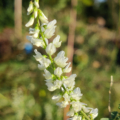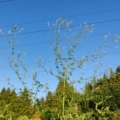Description
Melilotus albus | White Sweet Clover
White Sweet Clover, also known as Honey Clover, Sweet Clover, White Melilot, Common Melilot, Couronne Royale, Field Melilot, Hart’s Tree, Hay Flower, King’s Clover, and Bokhara clover, is a biennial legume that originated in Europe and is now widely distributed worldwide and occurs in nearly every state in the US. Most official sources consider Melilotus alba to simply be a color variant of Yellow Sweet Clover, Melilotus officinalis. Both are erect annual to biennial plants.
White Sweet Clover is typically a biennial, but sometimes flowers as an annual or a short-lived perennial with a lanky, sprawling appearance. The leaves look very similar to alfalfa leaves and the racemes of small white flowers, when blooming from July to October, attract all kinds of insect activity, including various species of bees, wasps, flies, butterflies, skippers, and beetles.
The genus name Melilotus comes from two Greek words Meli meaning “honey” and lotos, meaning “lotus”, all referring to the plant having abundant sweetness and being a favorite of bees. For centuries this white flowered biennial clover species has been excellent for honey production, providing good forage for livestock, and was once celebrated as the weed that saved Kentucky from economic ruin. Melilotus nectar averages 52% sugar and 48% water when grown in dry, alkaline soils. Most nectar is 20% sugar and 80% water. One can see why this is advantageous to the bees and to the beekeeper – each belly-load carries twice the sugar as typically found in other honey plants, effectively filling honey supers twice as fast.
White Sweet Clover thrives in full sun in an open site. It is best adapted to clay and heavy soils that range from slightly moist to dry, but also grows successfully on sandy soils with a high water table or irrigated dry soils (when adequately fertilized). Plant size will vary considerably with the moisture and fertility of the soil. Most places say the average size is 3-5 ft, but ours reached almost 9 ft!
It develops a deep tap root and like all Legumes, it fixes nitrogen in the soil and replenishes it. Plants are most commonly seen growing in prairies, old fields, vacant lots, limestone glades, thinly wooded bluffs, along railroads and roadsides, and in waste areas. This species has the potential to invade prairies and other natural habitats. Seeds remain viable in the soil for 14 to 20 years, and some have remained viable for more than 80 years.
This plant is edible, too! Young leaves can be eaten raw or cooked, preferably before the plant flowers. They are bitter and aromatic and are usually used added as flavoring in salads. Young shoots can be cooked and used like asparagus. The flowers, raw or cooked, are edible, too.
Type: Annual to biennial
Sun exposure: Full sun
Mature height: 3-9 ft
Mature width: 3-4 ft
Hardiness zones: 4-8













